|
|
|
Sort Order |
|
|
|
Items / Page
|
|
|
|
|
|
|
| Srl | Item |
| 1 |
ID:
072554
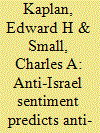

|
|
|
|
|
| Publication |
2006.
|
| Summary/Abstract |
In the discourse surrounding the Israeli-Palestinian conflict, extreme criticisms of Israel (e.g., Israel is an apartheidstate,theIsraelDefenseForcesdeliberatelytargetPalestiniancivilians),coupled with extreme policy proposals (e.g., boycott of Israeli academics and institutions, divest from companies doing business with Israel), have sparked counterclaims that such criticisms are anti-Semitic (for only Israel is singled out). The research in this article shines a different, statistical light on this question: based on a survey of 500 citizens in each of 10 European countries, the authors ask whether those individuals with extreme anti-Israel views are more likely to be anti-Semitic. Even after controlling for numerous potentially confounding factors, they find that anti-Israel sentiment consistently predicts the probability that an individual is anti-Semitic, with the likelihood of measured anti-Semitism increasing with the extent of anti-Israel sentiment observed.
|
|
|
|
|
|
|
|
|
|
|
|
|
|
|
|
| 2 |
ID:
072551
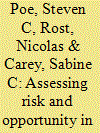

|
|
|
|
|
| Publication |
2006.
|
| Summary/Abstract |
Over the past two decades, substantial progress has been made toward a theoretical understanding of why physical integrity abuses are committed. Unfortunately, these theoretical developments have been devoid of much practical application. In this article, the authors explore the feasibility of risk assessment in the study of these human rights. Borrowing an approach by Gurr and Moore, they construct a risk assessment vehicle that uses existing models and data to develop expectations about future increases and decreases in human rights abuses. Their results indicate that we can isolate a set of cases that are at a higher risk of experiencing increased human rights abuse in the following year, as well as those that are ripe for better protection of human rights. The authors expect these risk and opportunity assessments to be of interest to students of conflict and peace studies, as well as to human rights activists and policy makers.
|
|
|
|
|
|
|
|
|
|
|
|
|
|
|
|
| 3 |
ID:
072550
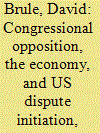

|
|
|
|
|
| Publication |
2006.
|
| Summary/Abstract |
Does congressional opposition constrain the president's conflict behavior in response to poor economic performance? Other research has shown that legislative constraints such as divided government reduce the executive's propensity to initiate conflict. But institutional constraints on democratic leaders may also make them likely to use force abroad when faced with deteriorating domestic conditions. The author argues that legislative constraints on presidential action during periods of economic decline compel the president to pursue alternatives that he can implement without congressional approval to display his leadership skills-including the use of military force abroad. The author examines the interactive effects of congressional opposition and economic performance on the propensity to initiate militarized interstate disputes from 1946 to 2000. The president is more likely to use force in response to economic decline when facing an opposition Congress than during years in which he enjoys partisan support in the legislature.
|
|
|
|
|
|
|
|
|
|
|
|
|
|
|
|
| 4 |
ID:
072556
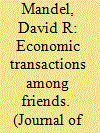

|
|
|
|
|
| Publication |
2006.
|
| Summary/Abstract |
Two experiments tested the idea that economic transactions among friends are influenced by a norm of generosity. Whereas a fairness norm ought to promote agreement in offers between buyers and sellers, a generosity norm should promote altruistic disagreements caused by sellers offering lower prices than buyers-a reversal of the well-known endowment effect. Supporting the present account, in both studies, offers among friends showed a reversal of the endowment effect. Moreover, disagreement in buying and selling offers was stronger among friends than among acquaintances, and (in study 2) the perceived generosity of offers, but not their perceived fairness, mediated this effect. Finally, both studies demonstrated that generosity is asymmetric: whereas selling offers among friends were generous by all comparative standards, buying offers were not.
|
|
|
|
|
|
|
|
|
|
|
|
|
|
|
|
| 5 |
ID:
072553


|
|
|
|
|
| Publication |
2006.
|
| Summary/Abstract |
This study leverages a statistical model to answer an empirical puzzle: given that popular conventional wisdom and many theories of ethnic conflict suggest that the ethnic composition of a society should influence the probability that a country experiences civil war, why are the results of large-n studies so contradictory? The author argues that confusion over the nature of the relationship between ethnic cleavages and the likelihood of civil war onset stems from a disconnect between ethnic conflict theory and empirical testing. Most studies that test for a relationship between the level of ethnic fractionalization and civil war onset test only for a direct relationship, while theories of ethnic conflict have suggested that ethnic diversity should have an indirect effect of the likelihood of civil war onset. The author uses a heteroskedastic probit model to show that ethnic fractionalization has an indirect effect on the likelihood of civil war onset.
|
|
|
|
|
|
|
|
|
|
|
|
|
|
|
|
| 6 |
ID:
072555
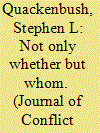

|
|
|
|
|
| Publication |
2006.
|
| Summary/Abstract |
Although in reality, states simultaneously pursue direct and extended deterrence, extant theories of deterrence have considered direct and extended deterrence situations separately. Furthermore, extended deterrence theories have not modeled all three actors in extended deterrence situations. To overcome these limitations in the literature, the author develops the three-party extended deterrence game and analyzes it with both complete and incomplete information, allowing conclusions to be drawn regarding deterrence and the related areas of alliance reliability and war expansion. For example, the findings indicate that deterrence is most likely to succeed when the alliance between Defender and Protégé is reliable. However, neither Defender nor Protégé wishes to be a more reliable ally than the other; if there is an asymmetry in reliability, Challenger will chose the more reliable state to attack in order to avoid a multilateral war. This counterintuitive conclusion was only reached by considering all three actors in extended deterrence.
|
|
|
|
|
|
|
|
|
|
|
|
|
|
|
|
| 7 |
ID:
072552
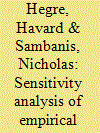

|
|
|
|
|
| Publication |
2006.
|
| Summary/Abstract |
In the literature on civil war onset, several empirical results are not robust or replicable across studies. Studies use different definitions of civil war and analyze different time periods, so readers cannot easily determine if differences in empirical results are due to those factors or if most empirical results are just not robust. The authors apply a methodology for organized specification tests to check the robustness of empirical results. They isolate causes of variation in empirical results by using the same definition of civil war and analyzing the same time period while systematically exploring the sensitivity of eighty-eight variables used to explain civil war in the literature. Several relationships with the onset of civil wars prove robust: large population and low income levels, low rates of economic growth, recent political instability and inconsistent democratic institutions, small military establishments and rough terrain, and war-prone and undemocratic neighbors. Variables representing ethnic difference in the population are robust only in relation to lower level armed conflict.
|
|
|
|
|
|
|
|
|
|
|
|
|
|
|
|
|
|
|
|
|